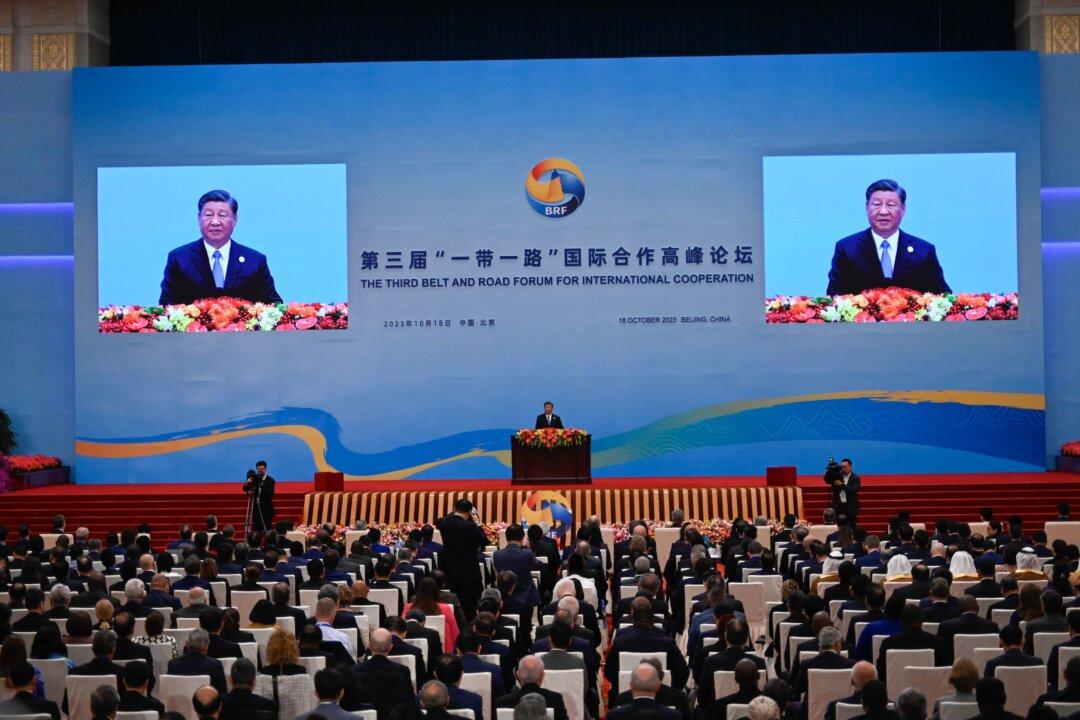Commentary
Twenty years ago last week, American aircraft bombarded Baghdad, starting the United States’ nine-year misadventure in Iraq.
Vice President Dick Cheney predicted that Americans would be “greeted as liberators.” This came true, but only briefly. Iraqi citizens—having endured decades of suffering under Saddam Hussein and his vicious, kleptocratic relatives and cronies—cheered when in just three weeks Americans routed Saddam’s army and defeated his Ba’athist government. Saddam had favored Iraq’s Sunni minority and kept Iraq subdued but stable. Many recall Saddam’s statue in Firdos Square being toppled over, and the Iraqis rushing to strike the prone figure with the soles of their shoes, a humiliating affront in Arab culture.
Perspectives have changed dramatically in two decades. Nearly all Iraqis and Americans now judge the invasion as the opening act in an epic tragedy. Once Saddam’s iron fist was gone, Iraqi society crumbled. The fractious Sunnis, Shi‘ites, and Kurds—restrained by Saddam’s dictatorial rule from turning on each other—devolved into internecine violence as kidnapping, torture, mass murder, and car bombs became commonplace. Al-Qaeda’s Iraqi franchise tried to replace Saddam and led the Sunni side against Shi’ites in a sectarian civil war from 2006 to 2008. And then, in a phantasmagoric twist, ISIS—the Islamic State of Iraq and Syria—metastasized in 2004 in response to the U.S. invasion. ISIS conquered one-third of Iraq, including the second-largest city of Mosul. ISIS ethnically cleansed Christians and Yazidis, awarded women as chattel prizes to its fighters, and video-recorded its cinematic medieval executions, which it showcased on social media.
Following the Obama administration’s half-hearted mismanagement, beginning in 2017, President Donald Trump’s merciless aerial strikes rid the world—at least temporarily—of the ISIS cancer. Yet Iraq remains in disarray. It’s today a client state of its erstwhile adversary and America’s most determined enemy, the Islamic Republic of Iran—indeed, when the U.S. assassinated Iranian Revolutionary Guard (IRGC) Commander Qasem Soleimani for orchestrating the killing of hundreds of U.S. soldiers, he was not in Iran, but in Iraq. Now Iran has re-established diplomatic ties with Saudi Arabia, an ominous development for the United States and its allies.
Americans regret the lack of any long-term plan for Iraq’s governance once Saddam was removed. They rue going to war on the discredited premises that Saddam aided al-Qaeda in planning 9/11 and that he possessed weapons of mass destruction. Although chemical weapons were found in Iraq, it was the alleged nuclear threat posed by Saddam that the United States had cited as its casus belli. However, focusing only on the errors and omissions of U.S. decisions from 2001 to 2003 misses the more important point. America’s ill-advised entry into Iraq was just one more episode in an ongoing series of foreign policy mistakes in the Middle East from the 1950s to the 1990s. These appear to many Americans as stand-alone events, separate and discrete, unconnected to one another. But in the fullness of time, Americans’ starry-eyed idealism and failure to learn from mistakes built upon one another, culminating in the catastrophe of 2003’s Operation Shock and Awe in Iraq.
The story of the United States’ and Iraq’s troubled entanglement actually begins decades ago in another country: Iran. Since 1941, Iran was ruled by Shah Mohammed Reza Pahlavi, a pro-Western and pro-American leader who allowed British and American companies to extract Iranian oil and receive the lion’s share of revenues. Angered by this foreign meddling, the Iranians in 1951 elected Mohammed Mossadegh, an avowed socialist, to serve as prime minister. Unlike previous prime ministers who deferred to the Shah, Mossadegh nationalized foreign oil companies, effectively kicking Westerners out of Iran.
The United States and Britain resented Mossadegh’s policies and feared that Mossadegh was insufficiently reliable and likely to accommodate the Soviet Union. In 1953, the CIA and MI6 overthrew Mossadegh and reinstalled the Shah as leader of the country.
However, in the mid-1970s, the Shah faced growing opposition at home—first from urban professionals peacefully seeking reform, then Shi'ite fundamentalists who hoped for an Ayatollah-governed theocracy, and finally the rural poor who chafed at the Pahlavi dynasty’s extravagance and his allowing American corporations to operate in Iran.
Although the United States had forcibly installed the Shah in 1953, President Jimmy Carter displayed waning confidence in the Shah. Visiting Tehran on New Year’s Eve 1977, Carter had praised the Shah’s regime as “an island of stability in one of the most troubled areas of the world.” Less than a year later, in a press conference in December 1978, Carter hedged his support for the Shah, proclaiming, “We personally prefer that the Shah maintain a major role, but that is a decision for the Iranian people to make.”
The Shah’s position deteriorated rapidly over the following weeks. Faced with the imminent disintegration of all civil order, the Shah departed for Egypt in January 1979, and within two weeks, the Shah’s long-exiled critic, Ayatollah Ruhollah Khomeini, returned to Iran and took over the country. This gave the Shah’s old nemesis, Saddam Hussein, an opportunity.
In 1980, Saddam’s army attacked Iran, intending to seize Iranian oil. Saddam also wanted to prevent the Shi’ite Iranians from rousing the two-thirds of Iraqis who were Shi’ite against Saddam’s Sunni-led government. Saddam thought that he would easily defeat Iran, which he viewed as destabilized after its 1979 revolution.
The Iran–Iraq War lasted until August 1988, ending in a stalemate. Saddam’s regime was financially depleted by this war, and in 1989–1990, he appealed to his Sunni Arab brethren in OPEC to raise oil prices in order to allow him to regain some of the money he had spent fighting Iran. OPEC was unmoved by his pleas, and refused to increase oil prices. Saddam gazed covetously upon tiny, neighboring Kuwait’s rich oil fields, which could give him more leverage with OPEC and rapidly put more money in his coffers. On Aug. 2, 1990, Saddam’s army invaded and plundered Kuwait.
President George H.W. Bush mobilized the United States along with 34 other allied countries, including Saudi Arabia, to launch Operation Desert Shield to contain Iraq, and then Operation Desert Storm to liberate Kuwait. Although the liberation of Kuwait was hailed worldwide as a victory because it succeeded at pushing Saddam’s army back into Iraq, it had unforeseen disastrous consequences. Only two years later, in February 1993, a bomb detonated in a stolen van in the underground garage of the World Trade Center in New York City, killing six and wounding more than 1,000, but leaving the Twin Towers intact. Eight and a half years later came the attacks of Sept. 11, 2001, which accomplished the goal—total destruction of the two buildings and a deep scar on the American psyche—that the 1993 bombing had failed to achieve.
When Osama bin Laden stepped forward on camera to claim al-Qaeda’s responsibility for 9/11, his announcement cited three grievances: (1) Israel’s mistreatment of the Palestinians; (2) the U.N.’s harsh economic sanctions on Iraq, which hurt and killed Iraqi children; and (3) the ongoing presence of American armed forces in Saudi Arabia, which in his opinion, defiled the Islamic holy sites of Mecca and Medina. Bin Laden’s causes (2) and (3) were direct consequences of the 1991 war—the United States imposed an embargo on Iraqi goods to punish Saddam for his invasion and, even after the First Gulf War ended, the United States left American troops in Saudi Arabia near and around the holy sites of Mecca and Medina, invigorating bin Laden’s desire to terrorize the United States in retaliation.
The unfortunate chain of events: the 1991 war was the consequence of Iraq’s invasion of Kuwait in 1990; Iraq’s invasion of Kuwait was the consequence of the Iran–Iraq War of 1980–1988; the Iran-Iraq war was the consequence of the Shah having being deposed in Iran in 1979; and the Shah having been deposed is a consequence of his being forcibly installed by the CIA and MI6, against the will of the Iranian people, in 1953.
It’s at least a strong possibility that if the Shah had remained in power in Iran, or had he not been installed in 1953 at all, none of those events that followed would have occurred in the way that they did, and perhaps not at all.
Those who don’t know history look at the world as a child does, with gentle intentions but with naivete and only a simplistic understanding, if any at all. In the fullness of time, seemingly winding and converging paths intersect. We cannot escape our mistakes.



